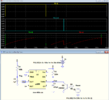Hello,
I am using a 555 timer circuit in a monostable mode. Its output is going to a relay through a buffer and the relay is connected to another circuit. The over all project is to turn on a device and have the device be on for a predetermined time UNLESS activity is detected. If a user uses the device, the device gets a 60kHz signal which gets converted to a short pulse. This pulse then is supposed to be used to reset the predetermined time of the 555 to start the time over. I have successfully integrated the 555 timer in this device so that it turns on and turns off in about 2 minutes (chose this time for test purpose) however where I am having an issue is using the signal to reset the time. I have attached a picture of my current 555 configuration. Please help me figure out how to: either set up an external circuit to help with the time reset or if you have better suggestions on a different timer.
Thank you for your time.
Parts Used:
NE555P timer
UA741 OpAMP (buffer connected to the output of 555)
C2 value 100uF (for a 2 minute time)
I am using a 555 timer circuit in a monostable mode. Its output is going to a relay through a buffer and the relay is connected to another circuit. The over all project is to turn on a device and have the device be on for a predetermined time UNLESS activity is detected. If a user uses the device, the device gets a 60kHz signal which gets converted to a short pulse. This pulse then is supposed to be used to reset the predetermined time of the 555 to start the time over. I have successfully integrated the 555 timer in this device so that it turns on and turns off in about 2 minutes (chose this time for test purpose) however where I am having an issue is using the signal to reset the time. I have attached a picture of my current 555 configuration. Please help me figure out how to: either set up an external circuit to help with the time reset or if you have better suggestions on a different timer.
Thank you for your time.
Parts Used:
NE555P timer
UA741 OpAMP (buffer connected to the output of 555)
C2 value 100uF (for a 2 minute time)


